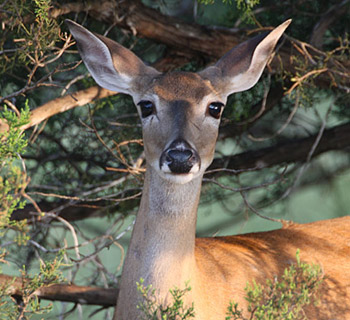Hurricane Dean in Mexico, very cool, light shower and breezy. River very high and fast.
- Continued to refresh hummingbird feeder
- Fewer feeders presented
- Saw Ruby throat
- Mostly Black-chinned (green back)
- Many animal tracks and dragonflies at pond
- Collected mulch from Oak Wilt clearing to beef up driveway behind house
- Treated poison ivy on steps to river with horticultural vinegar
- Added water to natural pond in bobcat draw with 2 hoses strung from well water faucet
Posted in
2007 Journal, Census, Habitat, Food, Water
Chiggers!
Caretaker's note: This is a sign that the fire ants are less numerous than before and under control. Have not seen (or felt) chigger bites for 10 years before.
Continued feeding hummingbirds
Caretaker's note: The large 15 ounce feeders do better in the deep shade. Also experimented with city chlorinated water instead of rain water and the feeding solution seemed to last longer.
Saw:
Caretaker's note: Cowbirds are a predatory species on songbirds previously discussed in a 2005 Journal entry. A few have been seen in the spring during nesting season but efforts to find them and shoot them failed. This 2007 photo shows the young cowbirds being introduced to a water source by their adoptive parents, the cardinals. Cowbirds are so named because they tend to be found near cattle operations. Historically, they adapted their predatory behavior to follow buffalo as they roamed to new grazing areas.
- Fox
- Raccoon
- Rock squirrel
- Squirrel
- Deer

Posted in
2007 Journal, Census, Predator, Food, Water
Rain! Finally, 1 inch or more, a good slow soaking. Birds very active in drizzle after rain.
Planted Buffalo Grass and watersto_jennystone mix around edges of roads near house
Many hummingbirds (20 or more) - Ruby Throated, Black Chinned, Rufous. Continued to feed hummingbirds and keep ant guards full. Yellow jacket wasps visiting hummingbird feeders, but harassing hummingbirds. Put up wasp trap.

Caretaker's note: The cup of water hung above the feeder keeps ants out of the hummingbird food. The water guards also provide another drinking place for thirsty birds in the drought.
The hummingbird feeding mixture is 4 parts water to 1 part plain white sugar. Do not cook to dissolve, just stir very well and keep refrigerated. It is not necessary to add red dye to the feeding mixture because the red color on the feeder will attract the hummingbirds.
Observations:
Caretaker's note: Continued feeding stations. Animals benefit from supplemental feeding, black oil sunflower seeds are a favorite for many species. Using 900 pounds a week
Posted in
2006 Journal, Census, Habitat, Food, Water
Hottest day - 95 degrees
- Watered all new plantings
- Beefed up lower swale below house with round rocks
- Lacewing eggs
- Saw pretty blue Dragonfly
- Turtle
- Sister butterfly (new species observed)
- Dealt with web worms
Caretaker's note: Web worms can be troublesome and unsightly, but are a good source of protein for the birds. Use a stick to tear open the web so that birds can easily access the worms.
Posted in
2006 Journal, Census, Erosion, Water
Still no rain, continued waterings (11 inches below normal)
- Saw small flock of Chipping Sparrows (approx 20)
- Fed animals (milo and black oil sunflower seeds)
Posted in
2006 Journal, Census, Food, Water


